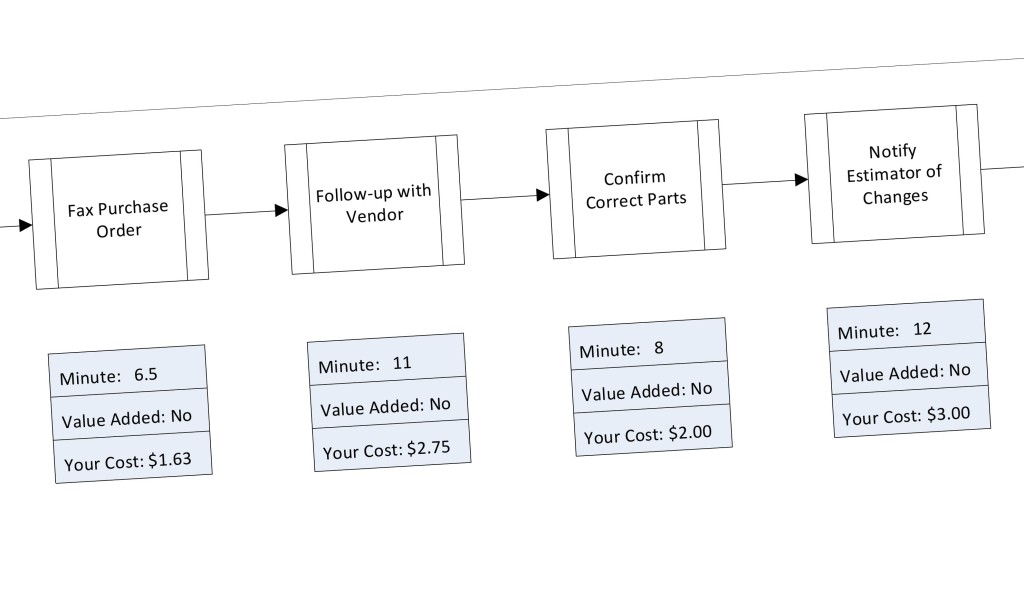
CIC releases snapshot of parts procurement process for ‘call and fax’ shop, seeks feedback
By onAnnouncements | Associations | Business Practices
A Collision Industry Conference group has reviewed a study tracking the parts procurement at one “call and fax” body shop and on Friday shared it with the industry to solicit input in advance of the July Detroit CIC.
The work used a flowchart prepared a few years ago by lean six sigma expert John Sweigart, principal at the Body Shop and also now an executive facilitator at DuPont, according to CIC parts panel Co-Chairman John Bosin of I-CAR.
Bosin said CIC updated the hourly wage (from $15 to what in some steps reaches $25 an hour) factored into Sweigart’s chart, which segments the parts process from loading an estimate to starting the install, and checked to ensure the steps were still correct for 2015. It is now releasing the results for discussion by the industry.
“We do want to vet it,” Bosin said.
Bosin said the research was derived by watching a single “call and fax” shop over time. The study found that the parts ordering process, which includes the time waiting for the delivery to arrive and 26 minutes for a technican finding, checking and reporting an issue with parts, took 27 hours and 11 minutes. This costs the shop $49.12, and that’s assuming the process doesn’t have to be repeated. (Apparently, whatever issue the technician found was a false alarm.)
The biggest time sucks identified by the research include waiting for the parts (1,440 minutes, or an entire day), which at least doesn’t cost the shop any wages, and several steps averaging 12 minutes (cost: $3 each), including reviewing the damaged parts after an estimate, notifying the estimator of any changes following the discussion with the vendor (which takes about 11 minutes after a 6.5-minute fax), checking in the parts, taking changes to an estimator yet again after that, moving the parts to the work area, and reviewing a parts issue found by the actual auto body technician.
Bosin said the CIC group concluded that the steps should stand, though careful blueprinting before this process starts could shave off some of this time.
“Please look at it, please ponder it, and then please send your comments – if any – to me and anyone else whom you want to copy,” Bosin wrote in an email Friday calling for input. “Please also socialize the map with your colleagues, vendors and customers for their insights, concerns and recommendations. We seek elucidation.”
The review doesn’t account for electronic parts procurement systems such as OPSTRAX, uParts and PartsTrader. It looks purely at the traditional “fax in an order to the jobber” system, which Bosin said data suggests is still in use by up to half the country’s body shops.
“It’s staggering,” he said.
He said anecdotally, he’s even heard, “You would be amazed … how many of our drivers come back with handwritten orders.” This refers not only to supplement orders and new ones handed in, but the drivers’ transcripts of orders verbally dictated to them.
A similar topic had been planned for discussion at the Atlanta CIC. However, it was sidetracked by the controversial revelation that PartsTrader had subsidized a repairer to attend the panel, and it generally failed to explore the advertise topic of parts procurement efficiency/inefficiency on more than a superficial level.
“Our approach is obviously different from the one taken in Atlanta,” Bosin wrote in a request for input on the flowchart. “Our panel format was flawed. Our format this time is academic and probably non-controversial. However, this approach should get at the heart of just where the inefficiencies are. When we identify them, the industry can address them.”
Find the chart here. Bosin can be reached at John.Bosin@i-car.com.
Images:
Featured image: A Collision Industry Conference group has reviewed a study tracking the parts procurement at one “call and fax” body shop and on Friday shared it with the industry to solicit input in advance of the July Detroit CIC. (maxoidos/iStock/Thinkstock)
Time sucks identified by the research include waiting for the parts (1,440 minutes, or an entire day), which at least doesn’t cost the shop any wages, and several steps averaging 12 minutes (cost: $3 each), including reviewing the damaged parts after an estimate, notifying the estimator of any changes following the discussion with the vendor (which takes about 11 minutes after a 6.5-minute fax), checking in the parts, taking changes to an estimator yet again after that, moving the parts to the work area, and reviewing a parts issue found by the actual auto body technician.

